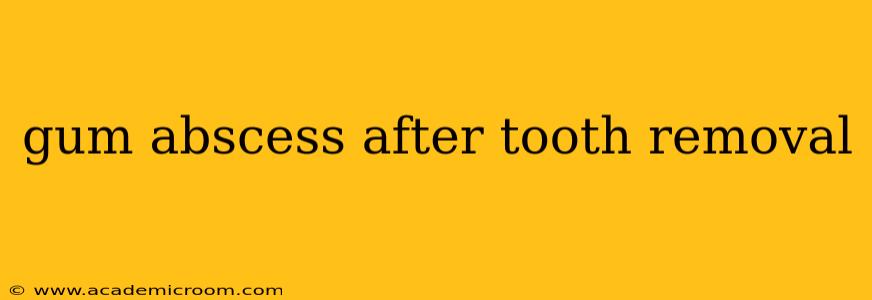A gum abscess after tooth removal, also known as a post-extraction alveolar osteitis, is a painful complication that can occur after having a tooth pulled. While not common, it's crucial to understand its causes, symptoms, and how to manage it. This detailed guide aims to provide comprehensive information on this dental issue, addressing common questions and concerns.
What Causes a Gum Abscess After Tooth Removal?
A gum abscess develops when bacteria infect the soft tissues surrounding the extraction site. This infection can arise from various factors, including:
- Incomplete removal of infected tissue: If fragments of infected tooth roots or other debris remain after the extraction, they can act as a breeding ground for bacteria, leading to an abscess.
- Poor oral hygiene: Inadequate brushing and flossing allow bacteria to accumulate in the mouth, increasing the risk of infection.
- Dry socket: This is a common cause of post-extraction abscesses. A dry socket occurs when the blood clot protecting the extraction site dislodges or dissolves prematurely, exposing the underlying bone and nerve endings to bacteria. This is excruciatingly painful and highly susceptible to infection.
- Compromised immune system: Individuals with weakened immune systems are more vulnerable to infections, including gum abscesses.
- Trauma to the extraction site: Injury to the gum tissue during or after the extraction can create an entry point for bacteria.
- Existing periodontal disease: Pre-existing gum disease increases susceptibility to post-extraction complications.
What are the Symptoms of a Gum Abscess After Tooth Removal?
Recognizing the symptoms early is vital for prompt treatment. Common symptoms include:
- Severe, throbbing pain: This is usually localized to the extraction site and may radiate to other parts of the face or jaw.
- Swelling and redness: The gums around the extraction site may become noticeably swollen and red.
- Pus: A yellowish or whitish discharge may be visible at the extraction site.
- Bad taste or odor: A foul taste or odor in the mouth is common with an infection.
- Fever and chills: In more severe cases, a systemic infection may develop, leading to fever and chills.
- Difficulty swallowing: If the abscess is large, it may make swallowing difficult.
- Swollen lymph nodes: The lymph nodes in the neck or jaw may become swollen.
How is a Gum Abscess After Tooth Removal Treated?
Treatment focuses on eliminating the infection and relieving symptoms. Your dentist will likely:
- Cleanse the extraction site: They'll remove any remaining debris or infected tissue.
- Irrigate the socket: This involves flushing the socket with a saline solution or antiseptic to remove bacteria.
- Prescribe antibiotics: Antibiotics are usually necessary to combat the infection.
- Pain relief medication: Over-the-counter pain relievers, like ibuprofen or acetaminophen, may be recommended, or your dentist may prescribe stronger pain medication.
- Provide oral rinses: Gentle antiseptic mouthwashes can help keep the area clean and prevent further infection.
- Placement of a medicated dressing: In cases of dry socket, a medicated dressing may be placed in the socket to promote healing.
Is a Gum Abscess After Tooth Removal Serious?
Yes, a gum abscess after tooth removal can be serious if left untreated. The infection can spread to surrounding tissues, leading to more severe complications like cellulitis (a skin infection), osteomyelitis (bone infection), or even sepsis (a life-threatening bloodstream infection). Therefore, prompt medical attention is crucial.
How Can I Prevent a Gum Abscess After Tooth Removal?
Prevention is always better than cure. You can reduce your risk of developing a gum abscess by:
- Maintaining good oral hygiene: Brush and floss regularly, especially after your tooth extraction.
- Following your dentist's post-operative instructions carefully: This includes avoiding smoking, using a straw, and rinsing vigorously.
- Eating a healthy diet: A healthy diet supports a strong immune system.
- Managing underlying medical conditions: Keeping chronic illnesses under control helps to boost your immune system.
How Long Does it Take for a Gum Abscess After Tooth Removal to Heal?
The healing time for a gum abscess varies depending on the severity of the infection and the individual's response to treatment. It can take anywhere from a few days to several weeks to fully heal.
When Should I See a Dentist?
If you experience any symptoms of a gum abscess after a tooth extraction, contact your dentist immediately. Early intervention is key to preventing serious complications.
This information is for general knowledge and does not substitute professional medical advice. Always consult your dentist or other qualified healthcare provider for any questions regarding your specific medical condition or treatment.
